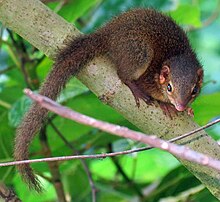Horsfield's treeshrew
| Horsfield's treeshrew | |
|---|---|

| |
| Scientific classification | |
| Domain: | Eukaryota |
| Kingdom: | Animalia |
| Phylum: | Chordata |
| Class: | Mammalia |
| Order: | Scandentia |
| Family: | Tupaiidae |
| Genus: | Tupaia |
| Species: | T. javanica[1]
|
| Binomial name | |
| Tupaia javanica[1] Horsfield, 1822
| |

| |
| Horsfield's treeshrew range | |
Horsfield's treeshrew (Tupaia javanica), also called Javan treeshrew, is a treeshrew species within the Tupaiidae. It is endemic to the Indonesian islands of Sumatra, Bali, Java and Nias where it inhabits foremost primary forest.[2]
It was first described by Thomas Horsfield in 1822.[3] Several subspecies have been proposed based on variation in colouration; however, colour is an unreliable distinguishing character.[4]
Characteristics
[edit]There are many variations of papillae on the surface of the Horsfield's treeshrew's tongue, which depend on the food it eats as well as the pattern and function of its tongue.[5] The Horsfield's treeshrew has a unique skull shape that better suits its environment and differs from other treeshrew species.[6]
Behavior and ecology
[edit]The Horsfield's treeshrew eats fruits and insects while mostly consuming arthropods.[5] It spreads plants seeds and controls insects, and therefore plays a significant role in the ecosystem; it has a special ability to adapt to agroforestry systems.[7]
References
[edit]- ^ Helgen, K.M. (2005). "Tupaia javanica". In Wilson, D.E.; Reeder, D.M. (eds.). Mammal Species of the World: A Taxonomic and Geographic Reference (3rd ed.). Johns Hopkins University Press. p. 106. ISBN 978-0-8018-8221-0. OCLC 62265494.
- ^ Jump up to: a b c Cassola, F. (2016). "Tupaia javanica". IUCN Red List of Threatened Species. 2016: e.T41496A22280464. doi:10.2305/IUCN.UK.2016-2.RLTS.T41496A22280464.en. Retrieved 26 January 2022.
- ^ Horsfield, T. (1824). Zoological researches in Java, and the neighbouring islands. Kingsbury, Parbury, & Allen.
- ^ Stone, R. D. (1995). Eurasian insectivores and tree shrews. IUCN. ISBN 2-8317-0062-0.
- ^ Jump up to: a b Gartiwa, G.; Damia, U.; Megawati, E.; Pradipta, S.; Gunawan, G.; Karnati, S.; Wihadmadyatami, H.; Kusindarta, D. (2021). "Morphological characterization of Horsfield's treeshrew Tupaia javanica lingual papillae: Light microscopy and scanning electron microscopy studies". Anatomia, Histologia, Embryologia. 50 (5): 801–811. doi:10.1111/ahe.12724. PMID 34184774. S2CID 235675524.
- ^ Endo, H.; Nishiumi, I.; Hayashi, Y.; Rerkamnuaychoke, W.; Kawamoto, Y.; Hirai, H.; Kimura, J.; Suyanto, A.; Nabhitabhata, J.; Yamada, J. (2000). "Osteometrical Skull Character in the Four Species of Tree Shrew". Journal of Veterinary Medical Science. 62 (5): 517–520. doi:10.1292/jvms.62.517.
- ^ Campera, M.; Hedger, K.; Birot, H.; Manson, S.; Balestri, M.; Budiadi, B.; Imron, M.; Nijman, V.; Nekaris, K. (2021). "Does the presence of shade trees and distance to the forest affect detection rates of terrestrial vertebrates in Coffee Home Gardens?". Sustainability. 13 (15): 8540. doi:10.3390/su13158540.
External links
[edit]![]() Data related to Tupaia javanica at Wikispecies
Data related to Tupaia javanica at Wikispecies

